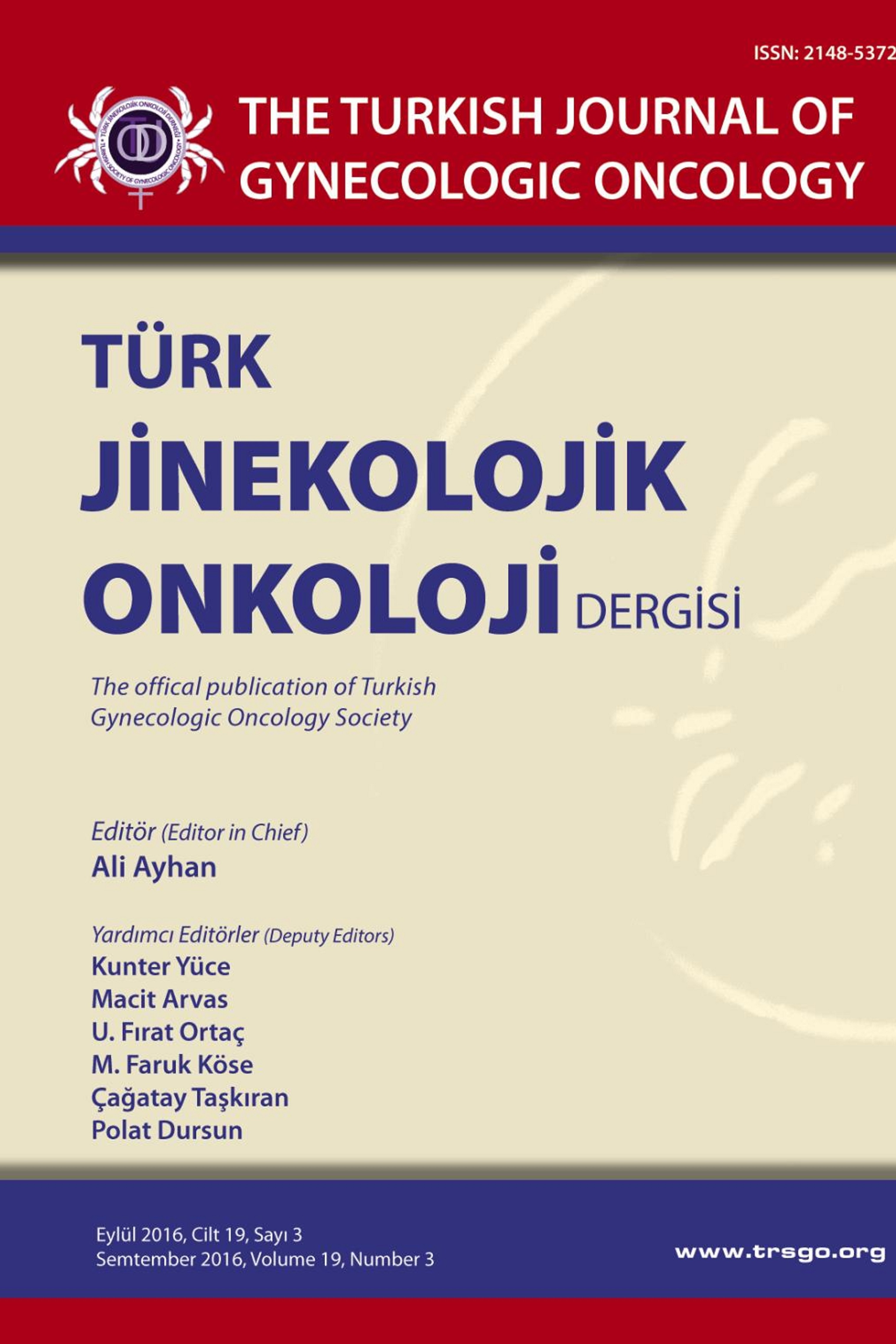Elif ÇINAR, Tayfun GÜNGÖR, Kamil MÜFTÜOĞLU, Mustafa ÖZAT, Özlem ALTINKAYA, Melike DOĞANAY, Ömer Lütfi TAPISIZ, Ümit BİLGE, Leyla Mollamahmutoğlu
NORMAL, HİPERPLASTİK VE NEOPLASTİK ENDOMETRİYUM DOKUSUNDA CYCLIN-E VE CASPASE-3 EKSPRESYONUNUN İMMÜNOHİSTOKİMYASAL ANALİZİ
Giriş: Hücre proliferasyonu ve apopitozisteki anormalliklerin endometriyal neoplazi oluşumu ve progresyonuna katkı sağladığı ileri sürülmektedir. Bu çalışma; hücre döngüsünde önemli rolü olan cyclin-E ve önemli bir apopitozis markerı olan caspase-3 düzeylerinin immünohistokimyasal olarak normal, hiperplastik ve neoplastik endometrium doku örneklerinde ekspresyonunu belirlemek ve bu markerların klinik önemini daha iyi kavramak amacıyla yapılmıştır. Materyal Metod: Hastanemizde myoma uteri nedeniyle histerektomi uygulanıp patolojide normal endometrium olarak değerlendirilmiş 23 hasta, menometroraji ön tanısıyla probe küretaj uygulanıp patolojide atipisiz basit hiperplazi olarak değerlendirilmiş 19 hasta ve endometriyal adenokarsinom ön tanısıyla opere edilip patolojide bu tanıları onaylanan 23 hasta olmak üzere toplam 65 hastanın doku örnekleri cyclin-E ve caspase-3 ekspresyonu yoğunluk ve yaygınlığı açısından immünohistokimyasal olarak incelenmiştir. Sonuçlar: Cyclin-E yoğunluğu normal endometrium dokusundan hiperplazi ve kanser dokusuna doğru anlamlı olarak artmıştı. Yaygınlık açısından ise cyclin-E ekspresyonu neoplastik dokuda hiperplastik ve normal endometriuma göre anlamlı olarak daha fazlaydı. Normal ve hiperplastik endometriyum arasında fark yoktu. Caspase-3 yoğunluğu açısından her 3 grup arasında anlamlı fark bulunmadı. Yaygınlık açısından neoplastik dokuda caspase-3 diğer iki gruba göre daha fazla ekprese edilmişti, bununla beraber normal endometriyum dokusunda caspase-3 yaygınlığı hiperplastik endometriyuma göre daha fazlaydı. Tartışma: Cyclin-E; endometriyum kanseri oluşumu ve/veya progresyonuyla, hem yoğunluk hem de yaygınlık açısından ilişkili bir marker olarak nitelendirilebilir. Caspase-3 yoğunluğunda her 3 grup arasında fark bulunamamasına rağmen, neoplastik endometriyumdaki yaygın caspase-3 boyanma oranı, caspase-3 bağımlı apopitotik yolağın endometriyal doku regülasyonuyla ilişkili olduğunu ve endometriyal neoplazi gelişimine katkıda bulunduğunu göstermektedir.
Anahtar Kelimeler:
Cyclin-E, caspase-3, endometriyal neoplazi
Objective: Abnormalities in the control of cell proliferation and apoptosis have been suggested to contribute to the development and progression of endometrial neoplasia. The present study aimed to investigate the immunohistochemical expression of cyclin-E (cell-cycle regulatory protein) and caspase-3 (apoptosis-related protein) in normal, hyperplastic and neoplastic endometrium. Methods: Paraffin-embedded specimens from normal endometrium (n=23), simple endometrial hyperplasia without atypia (n=19) and endometrial adenocarcinoma (n=23) were stained immuno-histochemically for both intensity and distribution of cyclin-E and caspase-3. Differences in expression between the tissues were analyzed. Results: Results: Intensity of cyclin-E gradually increased from normal through hyperplasia to carcinoma (p=0.040 hyperplastic versus normal endometrium, p=0.006 hyperplastic versus neoplastic endometrium, p<0.001 normal versus neoplastic endometrium). Distribution of cyclin-E significantly increased in neoplastic endometrium compared to normal and hyperplastic endometrium (p=0.002) whereas there was no significant difference between normal and hyperplastic endometrium. No significant difference was determined in all three groups for caspase-3 intensity. Neoplastic endometrium showed significantly higher diffuse expression than normal and hyperplastic endometrium (p=0.041 and p<0.001 respectively). However, distribution of caspase-3 in normal endometrium was significantly higher than that in hyperplastic endometrium (p<0.001). Conclusions: Cyclin-E is associated with carsinogenesis and disease development and/or progression in endometrial carcinoma with regard to diffusiveness and intensity. Despite the similar expression ratios between three groups in caspase-3 intensity, higher diffuse staining in carcinomatous endometrium may indicate that caspase-3 related apoptotic pathway is also involved in the regulation of endometrial tissue and promotes the development of endometrial neoplasia.
Keywords:
Cyclin-E, caspase-3, endometrial neoplasia,
- ISSN: 2148-5372
- Başlangıç: 2014
- Yayıncı: Türk Jinekolojik Onkoloji Derneği
Sayıdaki Diğer Makaleler
Elif ÇINAR, Tayfun GÜNGÖR, Kamil MÜFTÜOĞLU, Mustafa ÖZAT, Özlem ALTINKAYA, Melike DOĞANAY, Ömer Lütfi TAPISIZ, Ümit BİLGE, Leyla Mollamahmutoğlu
PRİMER SERVİKAL KORYOKARSİNOM: OLGU SUNUMU
Fuat Akercan, Mustafa Coşan Terek, Levent Akman, Yılmaz Dikmen, Osman Zekioğlu, Nedim Karadadaş, Necmettin Özdemir
VULVANIN PRİMER ADENOKARSİONOMU
Tevfik Güvenal, Feray Güvenal, D. Sema Arıcı
Gül Pınar, Şenay Topuz, Nevin Doğan, Lale Algıer
JİNEKOLOJİK ONKOLOJİDE ŞİLÖZ ASİT VE YÖNETİMİ
Hüsnü ÇELİK, Bilgin GÜRATEFL, Burçin KAVAK, Banu AYGÜN, Erhan AYGEN, Cem AYGÜN
